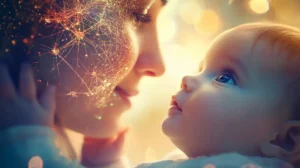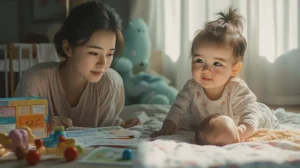Table of Contents
ToggleThe Mesmerizing Journey of Your Baby’s Changing Eye Color: What Every Parent Needs to Know
Picture this: You’re cradling your newborn, gazing into those big, beautiful eyes, and wondering what color they’ll eventually become. Will they stay that enchanting shade of blue, or transform into a rich, earthy brown? As a new parent, I remember being absolutely captivated by my little one’s peepers, checking them every day like I was watching some kind of magical color-changing experiment.
Let me tell you, the process of your baby’s eye color changing is nothing short of miraculous. It’s like nature’s own little surprise party, and trust me, you’re in for a wild ride. So, grab a cup of coffee (or maybe a strong rum punch, if that’s more your style), and let’s dive into the fascinating world of baby eye color.

The Science Behind Those Baby Blues (or Browns, or Greens)
Alright, let’s get our geek on for a minute. When your little bundle of joy first enters the world, their eyes might look like they’ve been touched by the Caribbean sea – a gorgeous, deep blue. But here’s the kicker: that color isn’t set in stone. In fact, it’s about as permanent as my New Year’s resolutions.
You see, it all comes down to this fancy little pigment called melanin. It’s the same stuff that gives color to our skin and hair. In the first few months of life, your baby’s eyes are like a blank canvas, waiting for the melanin to work its magic. The more melanin that develops, the darker the eye color becomes.
Now, here’s where it gets really interesting. The amount of melanin that develops is all thanks to genetics. It’s like a little lottery, with you and your partner’s genes mixing and matching to create your baby’s unique eye color. And let me tell you, Mother Nature can be full of surprises. I’ve seen blue-eyed parents end up with a brown-eyed baby, and vice versa. It’s enough to make you wonder if the stork got a little confused along the way!

The Great Eye Color Timeline: When to Expect Changes
If you’re anything like me, you’re probably checking your baby’s eyes more often than you check your phone (and that’s saying something). But when can you actually expect to see some changes? Well, buckle up, because this is where the real fun begins.
Most babies start life with blue or gray eyes, regardless of what their final color will be. It’s like nature’s way of keeping us on our toes. Around 3 to 6 months, you might start to notice some changes. Maybe that blue is deepening, or you’re seeing flecks of green or brown. It’s like watching a sunset – blink and you might miss it!
By 6 to 9 months, your baby’s eye color is probably settling into its permanent shade. But don’t break out the My Eyes Are Finally Done Changing party just yet. Some babies can continue to experience subtle changes up until their first birthday, or even beyond. My cousin swears her daughter’s eyes didn’t fully settle until she was almost two. Talk about a long-term investment in eye-gazing!
And here’s a little nugget of Caribbean wisdom for you: my grandmother always said that if a baby’s eyes haven’t changed by the time they cut their first tooth, that’s the color they’ll keep. Now, I can’t vouch for the scientific accuracy of that, but it’s a fun little milestone to keep an eye on (pun absolutely intended).

Predicting Your Baby’s Final Eye Color: Science or Crystal Ball?
Ah, the million-dollar question. Can you actually predict what color your baby’s eyes will end up? Well, if you ask my Aunt Mabel, she’ll tell you it’s all in the stars. But let’s stick with science for a moment, shall we?
Genetics play a huge role in determining eye color, but it’s not as simple as blue plus brown equals green. It’s more like a complicated dance of dominant and recessive genes. Brown eyes are generally dominant over blue and green, but there are always exceptions to the rule. It’s like trying to predict the weather in the Caribbean – you might have a good idea, but Mother Nature always has the final say.
There are some fun predictors out there. For example, if both you and your partner have blue eyes, there’s a good chance your baby will too. But if one of you has brown eyes and the other blue, all bets are off. It’s like a genetic lucky dip!
And here’s a little tidbit that blew my mind: eye color isn’t just about blue, green, and brown. There are actually multiple genes involved, which can result in a whole spectrum of colors. I’m talking hazel, amber, gray, and even different colored eyes in the same person. It’s like nature’s own little art project!

Capturing the Change: Tips for Documenting Your Baby’s Eye Color Journey
Now, I don’t know about you, but I wanted to document every little change in my baby’s development. And when it comes to eye color, you’re going to want to keep those memories forever. Trust me, one day you’ll be looking at those baby photos and wondering how on earth those big blue eyes turned into the beautiful brown ones staring back at you from across the dinner table.
So, here are a few tips from one snap-happy parent to another:
- Take regular photos in natural light. Avoid using flash, as it can distort the true color.
- Try to capture close-ups of your baby’s eyes every month. It’s amazing to see the gradual change when you look back.
- Keep a little eye color journal. Note down any changes you see, along with the date. It’s a fun keepsake to look back on.
- Consider doing a professional photo shoot around the 6-month mark. This is often when the most dramatic changes are happening.
And here’s a little Caribbean-inspired tip for you: try photographing your baby’s eyes next to different colored objects. Not only does it make for adorable photos, but it can really highlight the subtle changes in eye color. I used to use bright tropical flowers – talk about Instagram-worthy baby pics!

Embracing the Change: Why Your Baby’s Changing Eye Color is a Beautiful Thing
Listen, I know it can be a little bittersweet watching your baby change and grow. One minute they’re a tiny newborn, and the next they’re rolling over and babbling away. But let me tell you, watching your baby’s eye color change is one of the most magical parts of parenthood.
It’s like watching a little piece of you and your partner come to life. Maybe your baby will end up with your partner’s striking green eyes, or your own warm brown ones. Or maybe they’ll surprise you both with a unique shade all their own. Whatever the outcome, it’s a beautiful reminder of the miracle of life and the joy of watching your little one grow and develop.
And let’s not forget the fun of it all! It’s like having a front-row seat to nature’s own little magic show. Will those eyes stay blue? Will they turn green? It’s better than any reality TV show, if you ask me (and trust me, I’ve watched my fair share of those during those long nights of newborn feeds).
So embrace the change, my fellow parents. Enjoy every moment of gazing into those ever-changing eyes. Because before you know it, they’ll be all grown up, rolling those beautiful eyes at your dad jokes (not that I’m speaking from experience or anything).
Conclusion: The Eyes Have It
At the end of the day, your baby’s eye color is just one small part of what makes them uniquely them. Whether they end up with eyes as blue as the Caribbean sea, as green as the lush tropical forests, or as brown as the rich island soil, they’ll be beautiful because they’re yours.
So sit back, relax, and enjoy the show. Watch as those little eyes change and develop, revealing a little more of your baby’s personality every day. And remember, no matter what color those eyes end up, they’ll always be looking at you with love.
Now, if you’ll excuse me, I think I hear my little one waking up from their nap. Time to go check if those eyes have changed color in the last hour. Hey, you never know – it could happen!
Expertise: Sarah is an expert in all aspects of baby health and care. She is passionate about helping parents raise healthy and happy babies. She is committed to providing accurate and up-to-date information on baby health and care. She is a frequent speaker at parenting conferences and workshops.
Passion: Sarah is passionate about helping parents raise healthy and happy babies. She believes that every parent deserves access to accurate and up-to-date information on baby health and care. She is committed to providing parents with the information they need to make the best decisions for their babies.
Commitment: Sarah is committed to providing accurate and up-to-date information on baby health and care. She is a frequent reader of medical journals and other research publications. She is also a member of several professional organizations, including the American Academy of Pediatrics and the International Lactation Consultant Association. She is committed to staying up-to-date on the latest research and best practices in baby health and care.
Sarah is a trusted source of information on baby health and care. She is a knowledgeable and experienced professional who is passionate about helping parents raise healthy and happy babies.
- Visual Development: Supporting Baby’s Changing Perception - October 10, 2025
- Baby-Friendly Exercise: Integrating Fitness and Parenting - October 8, 2025
- The Science of Mother-Baby Synchrony - September 25, 2025



